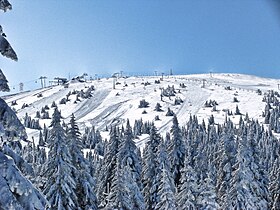Kopaonik National Park
| Kopaonik | |
|---|---|

Pančić's Peak, during winter
|
|
| Highest point | |
| Peak | Pančić's Peak |
| Elevation | 2,017 m (6,617 ft) |
| Coordinates | 43°16′09″N 20°49′21″E / 43.26917°N 20.82250°ECoordinates: 43°16′09″N 20°49′21″E / 43.26917°N 20.82250°E |
| Geography | |
| Location | Serbia and Kosovo |
|
IUCN category II (national park)
|
|

Kopaonik National Park
|
|
| Area | 121.06 km2 (46.74 sq mi) |
| Established | 1981 |
| Kopaonik ski resort | |
|---|---|

Nebeske Stolice hotel at Kopaonik
|
|
| Location | Kopaonik, |
| Nearest city | Brus, Serbia |
| Coordinates | 43°16′9″N 20°49′21″E / 43.26917°N 20.82250°E |
| Top elevation | 2,017 m |
| Base elevation | 1,770 m |
| Skiable area | 62 km |
| Runs | 24 |
| Longest run | 3.5 km |
| Lift system | 28 total (8-passenger gondola (u/c), 3 high-speed 6-passenger Superchairs, 7 High-speed quad chairs, 2 double chairs, 11 Surface and 3 kid-surface) |
| Lift capacity | 32,000/hour |
| Website | Kopaonik |
Kopaonik (Albanian: Kopaoniku, Serbian Cyrillic: Копаоник, Serbian pronunciation: [kɔpaɔ̌niːk]) is a mountain in the central part of Serbia and the largest mountain range in the country. The highest point is the Pančić's Peak with 2,017 m (6,617 ft).
Kopaonik is a major ski resort in Serbia, and after Bulgaria's Bansko, the largest in Southeast Europe. There are 25 ski lifts with capacity of 32,000 skiers per hour.
The central part of the Kopaonik plateau was declared a national park in 1981 which today covers an area of 121.06 km2 (46.74 sq mi).
Stretching for 75 km (47 mi) in the north-south direction, between the rivers of Lab and Sitnica on the south and Jošanica on the north, Kopaonik is the largest and longest mountain range in Serbia. It belongs to the region of Raška. The Kopaonik mountain massif (Kopaoničke planine) includes the mountains of Kopaonik, Željin, Goč and Stolovi. The Pančić's Peak, with 2,017 m (6,617 ft), is the highest point of the mountain.
Snow season lasts from November to May, while there are 200 sun days.
Due to its rich mines, Kopaonik was originally named Silver Mountain (Serbian: Сребрна планина, translit. Srebrna planina) and that name was also used by the Romans, Venetians and Ottomans. Its current name, originally Kopalnik, is also connected to the ore mining as it comes from kopati, Serbian for digging.
...
Wikipedia

